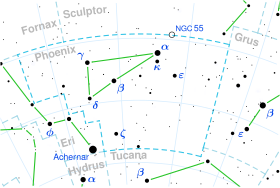HD 222095
HD 222095| 관측 데이터 에폭 J2000 이쿼녹스 J2000 | |
|---|---|
| 별자리 | 피닉스 |
| 우측 상승 | 23h 37m 50.99418s[1] |
| 탈위임 | −45° 29′ 32.4672″[1] |
| 겉보기 크기 (V) | 4.74[2] |
| 특성. | |
| 진화 단계 | 주계열 |
| 스펙트럼형 | A1/2V[3] |
| U-B색지수 | +0.09[2] |
| B-V색지수 | +0.08[2] |
| 아스트로메트리 | |
| 방사 속도 (Rv) | +3.40km[4]/s |
| 고유 운동 (μ) | RA: +70.71[1]mas/yr Dec.: −12.66[1]mas/yr |
| 시차 (π) | 16.29 ± 0.22[1] 마스 |
| 거리 | 200 ± 3 리 (61.4 ± 0.8 pc) |
| 절대치수 (MV) | 0.80[5] |
| 세부 사항 | |
| 미사 | 2.55[6] M☉ |
| 반지름 | 2.2[7] R☉ |
| 루미도 | 41.42[5] L☉ |
| 표면 중력 (log g) | 3.92[6] cgs |
| 온도 | 9,230[6] K |
| 금속성 [Fe/H] | -0.01[8] 덱스 |
| 회전 속도 (v sin i) | 시속 141km[6] |
| 나이 | 482[6] 마이어 |
| 기타 지정 | |
| 데이터베이스 참조 | |
| 심바드 | 자료 |
HD 222095는 그루스자리와의 서쪽 별자리 경계 부근인 피닉스 남쪽 별자리에 있는 단일[10] 별이다. 흰색 빛깔을 띠며 육안으로는 4.74의 외관상 시야로 볼 수 있다.[2] 이 별은 시차 기준 약 200광년 거리에 위치해 있으며,[1] 방사상 속도 +3.4 km/s로 더 멀리 떠내려가고 있다.[4]
이 물체는 A형 주계열성으로 항성 분류는 A1/2V이다.[3] 141[6]~165km/s의 예상 회전속도로 회전속도가 높아 극지반경보다 4%나 큰 적도 돌출부를 갖고 있다.[11] 이 별은 태양 질량의 2.55배, 태양의 반지름의 약 2.2배인[6][7] 4억 8천 2백만년 된 것이다. 그것은 유효 온도 9,230 K로 광권으로부터 태양의 41배[5] 광도를 방사하고 있다.[6] 별의 외부 대기의 화학적 풍부함은 태양과 비슷하다.[8]
참조
- ^ a b c d e f Van Leeuwen, F. (2007). "Validation of the new Hipparcos reduction". Astronomy and Astrophysics. 474 (2): 653–664. arXiv:0708.1752. Bibcode:2007A&A...474..653V. doi:10.1051/0004-6361:20078357. S2CID 18759600. Vizier 카탈로그 항목
- ^ a b c d Ducati, J. R. (2002). "VizieR Online Data Catalog: Catalogue of Stellar Photometry in Johnson's 11-color system". CDS/ADC Collection of Electronic Catalogues. 2237. Bibcode:2002yCat.2237....0D.
- ^ a b Houk, Nancy (1978). Michigan catalogue of two-dimensional spectral types for the HD stars. Vol. 2. Ann Arbor: Dept. of Astronomy, University of Michigan. Bibcode:1978mcts.book.....H.
- ^ a b Gontcharov, G. A. (2006). "Pulkovo Compilation of Radial Velocities for 35 495 Hipparcos stars in a common system". Astronomy Letters. 32 (11): 759–771. arXiv:1606.08053. Bibcode:2006AstL...32..759G. doi:10.1134/S1063773706110065. S2CID 119231169.
- ^ a b c Anderson, E.; Francis, Ch. (2012). "XHIP: An extended hipparcos compilation". Astronomy Letters. 38 (5): 331. arXiv:1108.4971. Bibcode:2012AstL...38..331A. doi:10.1134/S1063773712050015. S2CID 119257644. Vizier 카탈로그 항목
- ^ a b c d e f g h David, Trevor J.; Hillenbrand, Lynne A. (2015). "The Ages of Early-Type Stars: Strömgren Photometric Methods Calibrated, Validated, Tested, and Applied to Hosts and Prospective Hosts of Directly Imaged Exoplanets". The Astrophysical Journal. 804 (2): 146. arXiv:1501.03154. Bibcode:2015ApJ...804..146D. doi:10.1088/0004-637X/804/2/146. S2CID 33401607. Vizier 카탈로그 항목
- ^ a b Pasinetti Fracassini, L. E.; et al. (February 2001), "Catalogue of Apparent Diameters and Absolute Radii of Stars (CADARS)", Astronomy and Astrophysics (Third ed.), 367 (2): 521–524, arXiv:astro-ph/0012289, Bibcode:2001A&A...367..521P, doi:10.1051/0004-6361:20000451, S2CID 425754
- ^ a b Gontcharov, G. A. (2012). "Dependence of kinematics on the age of stars in the solar neighborhood". Astronomy Letters. 38 (12): 771–782. arXiv:1606.08814. Bibcode:2012AstL...38..771G. doi:10.1134/S1063773712120031. S2CID 118345778. Vizier 카탈로그 항목
- ^ "HD 222095". SIMBAD. Centre de données astronomiques de Strasbourg. Retrieved 2019-11-19.
- ^ Eggleton, P. P.; Tokovinin, A. A. (2008). "A catalogue of multiplicity among bright stellar systems". Monthly Notices of the Royal Astronomical Society. 389 (2): 869. arXiv:0806.2878. Bibcode:2008MNRAS.389..869E. doi:10.1111/j.1365-2966.2008.13596.x. S2CID 14878976.
- ^ van Belle, Gerard T. (March 2012). "Interferometric observations of rapidly rotating stars". The Astronomy and Astrophysics Review. 20 (1): 51. arXiv:1204.2572. Bibcode:2012A&ARv..20...51V. doi:10.1007/s00159-012-0051-2. S2CID 119273474.



